
This is where you find all our press releases and news articles.
The following shows you a large-scale compound feed mill project with an annual output of 300,000 tons, with an output of 125t/h. The compound feed factory is mainly used to process chicken feed, goose feed, pig feed and aquatic feed. The aquatic feed produced by this compound feed mill project includes grass carp feed, carp feed and shrimp feed, and does not use the puffing process.
In addition, the compound feed factory contains 4 animal feed pellet production lines, of which three livestock and poultry feed lines process pellet feed and powder feed at the same time.
With the development and progress of society and the improvement of people's living standards, especially the acceleration of the pace of life, people's demand for the variety structure of poultry and meat products has also undergone great changes. Ecological, organic, safe, nutritious and delicious meat products It is becoming more and more popular among the masses.
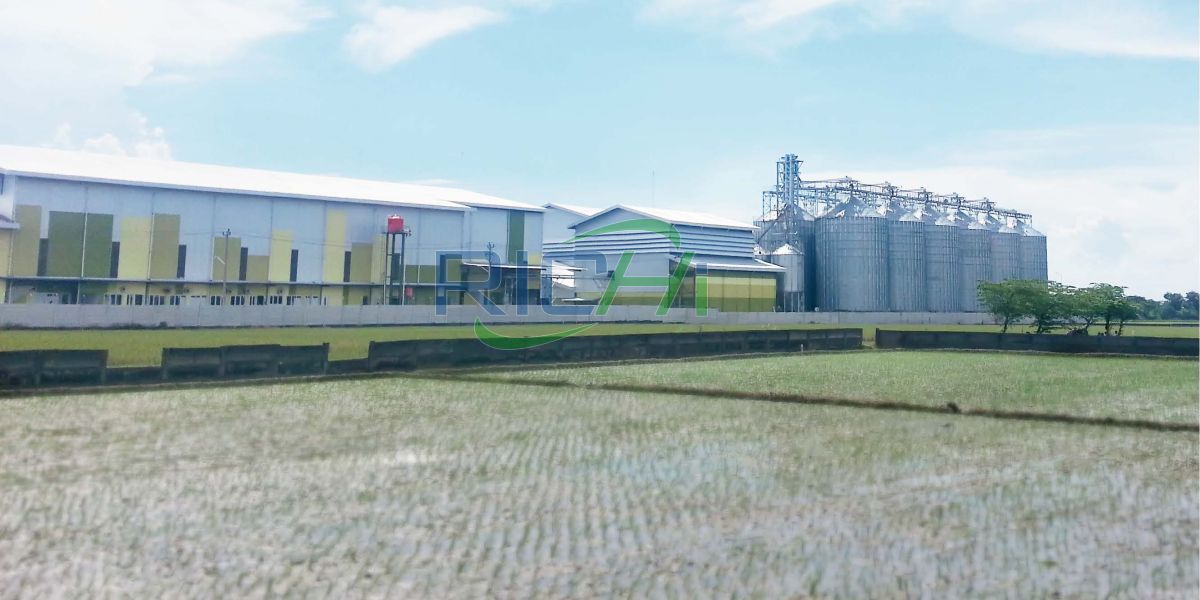
The implementation of this compound feed mill project will not only promote the development of the breeding industry, but also promote the development of related auxiliary industries. Such as promoting the development of feed processing industry, packaging materials, material circulation, etc.
This project uses local breeding resources for processing, reducing transportation costs and improving the quality of raw materials. The products will be mainly sold to the Asian market. After the implementation of this compound feed mill project, its economic and social benefits are very significant.
The customer's animal feed company was founded in 1999 and is mainly engaged in feed processing, production and operation. The customer owns a feed factory with a production capacity of 180,000 t/a of livestock, poultry, and aquatic feed.
However, due to government planning reasons where the customer is located, the original factory can no longer continue production, so the customer has to relocate and invest tens of millions to build this high-end livestock and poultry aquatic compound feed mill project with an annual output of 300,000 tons to increase feed production capacity.
At the same time, this relocation will be used to eliminate outdated equipment and improve related environmental protection projects.
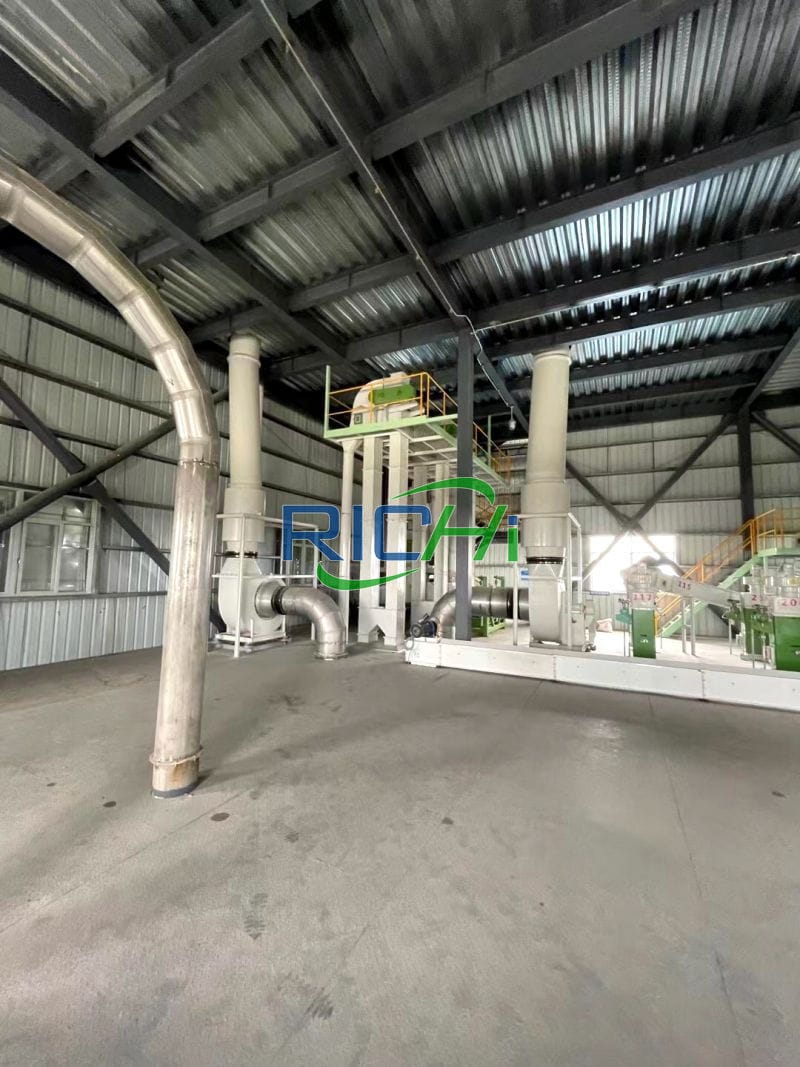
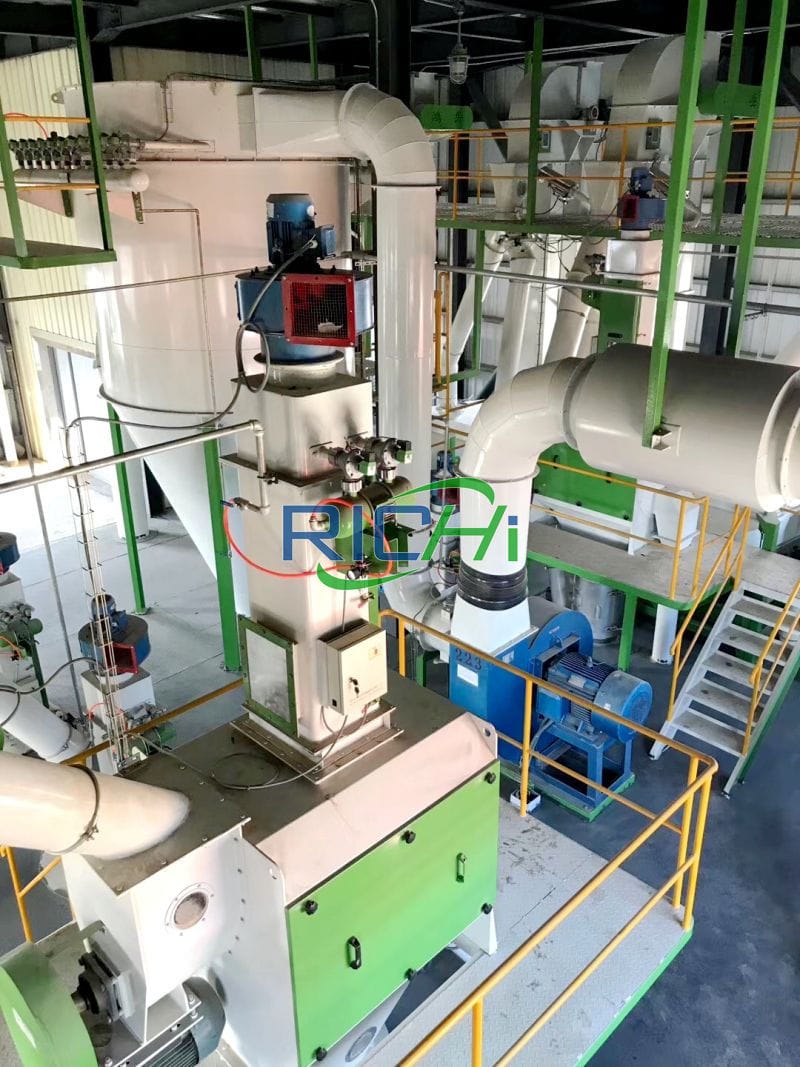
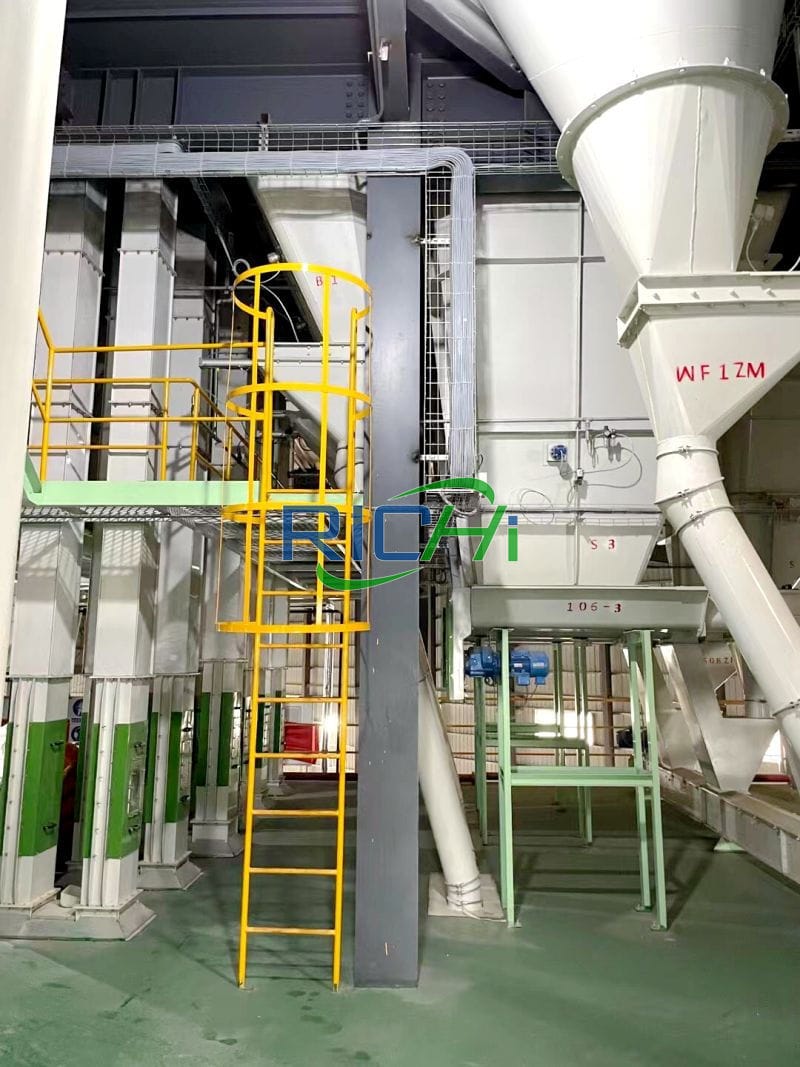
| Product Name | Capacity |
| High-end and high-quality livestock and poultry feed (chicken, duck, pig feed, etc.) | 270,000 tons/year (75% pellets, 25% powder) |
| Aquatic feed | 30,000 tons/year (80% pellets, 20% powder) |
| Name | Dosage t/a | Maximum storage capacity | Storage period | Storage method |
| Corn | 168000 | 6000t | 28 days | 4 silos, with a storage capacity of 1500t/set. |
| Soybean meal | 34700 | 1000t | 35 days | 4 silos, with a storage capacity of 250t/set. |
| Wheat | 29600 | 1200t | 25 days | 50kg bag |
| Wheat middlings | 1600 | 200t | 45 days | 50kg bag |
| Bran | 30200 | 400t | 75 days | 50kg bag |
| Rapeseed meal | 2890 | 150t | 19 days | 50kg bag |
| Cotton meal | 3020 | 500t | 2 months | 50kg bag |
| Name | Dosage t/a | Maximum storage capacity | Storage period | Storage method |
| Wheat | 6000 | 800t | 40 days | 50kg bag |
| Soybean meal | 10200 | 500t | 20 days | There are 2 silos in total, with a storage capacity of 250t/piece |
| Bran | 3870 | 200t | 19 days | 50kg bag |
| Rapeseed meal | 5600 | 300t | 19 days | 50kg bag |
| Fishmeal | 4340 | 500t | 40 days | 50kg bag |
| Equipment Name | QTY |
| Twin-shaft paddle mixer | 3 |
| Crusher | 3 |
| Cylindrical primary cleaning screen | 3 |
| Permanent magnet screen | 3 |
| Animal feed pellet machine | 3 |
| Crusher | 1 |
| Conveyor | 6 |
| Scraper machine | 12 |
| Bucket elevator | 16 |
| Packing Machine | 6 |
| Grading screen | 3 |
Calculating the annual working hours as 2400 hours, the annual crushing capacity of the crusher on a single livestock and poultry feed production line is 96,000t, the annual mixing capacity of the mixer is 96,000t/h, the annual granulating capacity of the animal feed pellet making machine is 72,000t, and the annual screening capacity of the screening machine is 72,000t, the annual crushing capacity of the crusher is 43,200t, and the three livestock and poultry production lines can meet the production capacity of 270,000 tons of livestock and poultry feed.
| Equipment Name | QTY |
| Twin-shaft paddle mixer | 1 |
| SIngle-shaft paddle mixer | 1 |
| Feed hammer mill crusher | 1 |
| Cylindrical primary cleaning screen | 1 |
| Permanent magnet screen | 1 |
| Vertical twin-shaft crusher | 1 |
| Fish feed pellet making machine | 1 |
| Packing Machine | 2 |
| Grading screen | 1 |
| Vertical silo complete equipment(1500T) | 4 |
| Vertical silo complete equipment(250T) | 6 |
| Testing equipment | 6 |
The granulation capacity is 24,000t, and the annual screening capacity of the screening machine is 24,000t, which can meet the production capacity of 30,000 tons of aquatic feed.
| Equipment Name | QTY |
| Vertical silo complete equipment(1500T) | 4 |
| Vertical silo complete equipment(250T) | 6 |
| Testing equipment | 6 |
| 3 Ton Steam boiler (including gas pipeline) | 2 (one for use and one for backup) |
| Soft water preparation system(4m3 /h) | 1 |
| Transformer(1000kVA) | 2 |
| Refrigeration Compressors | 1 |
| Cooling System | 1 |
| Bag filter | several |
| Fan | 4 |
The water used in the factory comes from the municipal water supply network for production and domestic use, which can meet the needs of this 125t/h compound feed mill project.
There are 80 employees. There is a canteen and accommodation in the factory. The water consumption for employees is calculated as 120L/person·d, and the water consumption in the canteen is calculated as 25L/person·meal. The domestic water consumption is 11.6m3/d, that is, 3480m3/a.
Domestic sewage generated amount is calculated based on 80% of the water consumption, then the domestic sewage production volume is 9.28m3/d, that is, 2784m3/a. After being pre-treated by grease traps and septic tanks, domestic sewage enters the sewage treatment plant through the municipal sewage pipe network for treatment.
The 125t/h compound feed mill project is equipped with a 3t/h gas boiler, the steam supply is 3t/h, the boiler operating time is calculated as 1350h/a, the steam generated by the boiler is used for direct heating, and direct heating consumes steam. This evaluation is based on the total amount of steam generated.
Consumption calculation, steam production is 13.5t/d, 4050t/a. Soft water needs to be used when boiler water is used. The soft water production process is ion exchange resin method. The treatment scale is 4m3/h. The preparation rate is calculated as 75%.
When preparing boiler soft water required amount of tap water is 5400t/a, and the amount of concentrated water produced is 1350t/a. This part of the concentrated water is mainly clean sewage with high salt content, which is directly discharged into the sewage treatment plant for treatment.
Combined with the existing site conditions, the floor plan of the 125t/h compound feed mill is designed with the best aniaml feed production processes (logistics, people flow, information flow, energy flow) and production process engineering.
The overall layout emphasizes the rationality of logistics and reduces the return, crossover, and round-trip of logistics. Wait for efficient handling; reduce inventory and work-in-progress, shorten stagnation and waiting for materials; choose appropriate loading and unloading handling methods and machinery.
The overall layout follows the principles of intensive and compact land use, reasonable functional zoning, smooth process flow, and short transportation lines.
The building layout is combined with the shape of the land, fully considering the requirements for sunlight, ventilation, and fire protection, and at the same time, it is coordinated with the surrounding environment.
When laying out the general layout, strictly follow the relevant provisions of the "Code for Fire Protection Design of Buildings" .
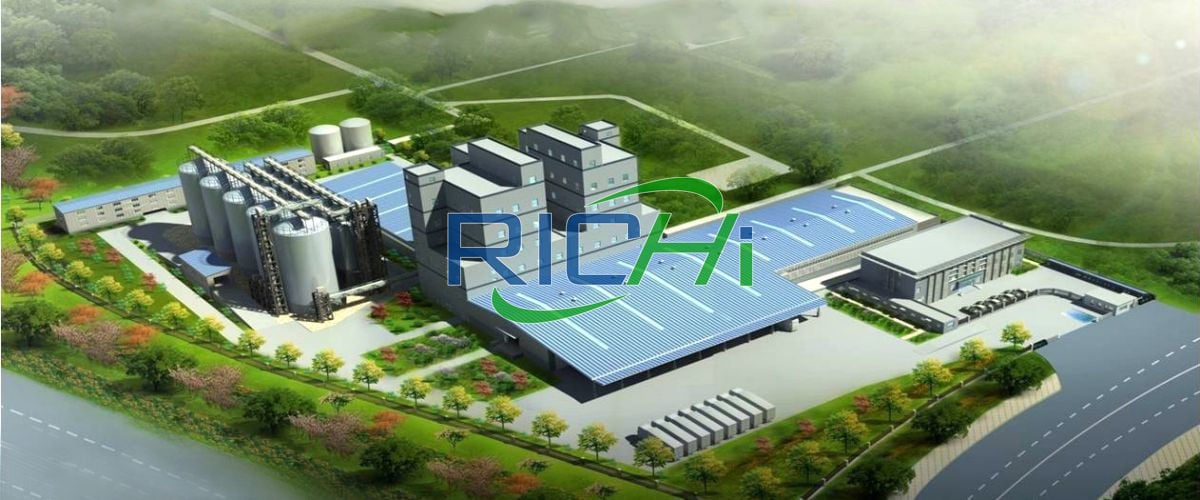
01
Raw material receiving (unloading, feeding):
02
Impurity removal and crushing (sieving, magnetic separation, crushing):
03
Ingredients:
04
Mixing:
05
Granulation:
06
Cooling:
07
Crumbling:
08
Screening, inspection and packaging:
09
Inspection:
Note:
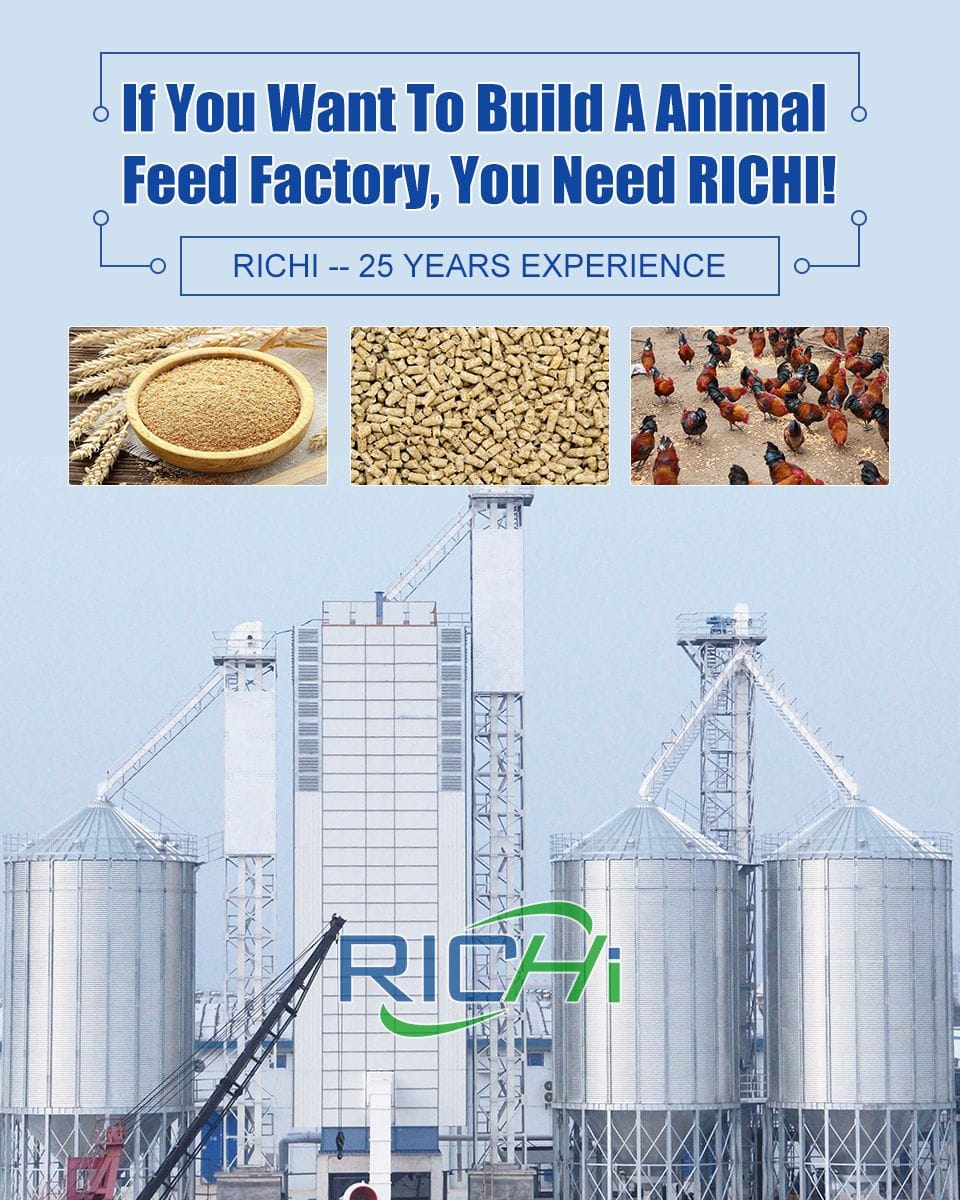
The above is an example of a 125t/h compound feed mill cited by RICHI.
It is worth mentioning that in this large compound feed mill project, RICHI provided a complete set of animal feed mill machine for the chicken feed production line and aquatic feed production line. Pig feed and goose feed production lines are provided by two other manufacturers from Europe.
As I believe you can see from the above, if you want to start a large 125t/h compound feed mill, our animal feed solutions help you produce top quality feed and to make economical use of your raw materials and energy. As a technology partner with long-lasting experience in the industry, we support you in every aspect of the production of reliable animal feed.
No matter which country you want to build a compound feed mill, our thousands of cases are enough to prove that we can give you professional technical support and a large number of construction plans! Contact Richi Machinery at any time to get the most valuable solutions and the most effective communication.
Having the right mix of reliable, high-quality pellet machine and pelletizing systems and expert support is essential to your success. Watch how our end-to-end feed pellet plant solutions have helped our customers optimize their performance.
Our customized and future-proofed turnkey pellet plant solutions is designed with you at the core. From vision to reality and beyond, our team stays connected with yours. Giving you peace-of-mind with an expert at your side.

At RICHI, we go beyond project completion. With RICHI Servicee, we’re your dedicated partners in success. Count on us for expert guidance, minimal downtime, and optimized productivity. Choose RICHI for unmatched service and support.



Meet global product demands and quality standards with industry-leading pellet plant design, engineering, equipment, and construction services for pellet processors.


Your Partner Beyond Project Completion
2000+ cases
RICHI is the leading designer, manufacturer and builder of pellet plants in the world, completing over 2000 projects in 140 countries across 6 continents.
Read More
Increase plant productivity, profitability, and safety by integrating high quality equipment into your pellet production line. Over the years, RICHI has become China's top pellet equipment manufacturer. At the same time, RICHI has established valuable partnerships with the world's leading component and raw material manufacturers to bring you the best there is in technology, automation, and efficiency in pelleting plant machinery.

For nearly 30 years, RICHI has been providing best-in-class pellet plant equipment and services to clients across a variety of industries, sizes, and needs. We pride ourselves on the knowledge and skill that each team member possesses – from our technical sales team to our process design engineers. You can count on RICHI Machinery to take your operation to the next level of innovation, quality, and success.
Need help with your pellet manufacturing plant project? Contact us today.
ANIMAL FEED
BIOMASS
WOOD
ORGANIC FERTILIZER
AQUA FEED
CAT LITTER
MUNICIPAL WASTE RECYCLING
SPECIAL PELLET PRODUCTION
RICHI Machinery continues to deliver world class pellet mill equipment, pellet plant engineering and project solutions that add value to our customers in the animal feed, wood waste, agriculture waste, organic fertilizer, cat litter and special pellet products industries. Throughout the years, we RICHI Machinery have built strong brand, becoming industry-leading pellet machine manufacturer. We value integrity, promise quality, and prioritize your success.
Learn MoreWith our expert team, we precisely implement your process engineering requirements in pellet mill and pelletizing plant systems. No matter which industry you’re in – we understand your needs and deliver solutions that meet the highest standards.
At RICHI, quality comes first. Our pellet making machine and related pellet line equipment undergo rigorous quality controls to ensure they meet the highest standards. Rely on products that are durable, safe, and efficient.
With decades of experience in pellet machine and pellet production line production, we have earned a reputation as a trusted partner in various industries. Our expertise allows us to cover a wide range of applications.
Not only do we offer premium pelleting equipment, but we are also experts at designing, building, installing, and maintaining facilities from the ground up. Our expertise is within pellt plant process design, discovering the most efficient, productive, and profitable way to handle your materials in an end-to-end cycle.

Keeping in touch with us is an effective way to solve all your problems. If you have any needs or questions, please leave your contact information, then RICHI technical consultants will send design, quotation, videos to your mailbox. You can also contact us directly via WhatsApp: +86 13838389622
Copyright©2015-2024 by HENAN RICHI MACHINERY CO., LTD. All rights reserved.